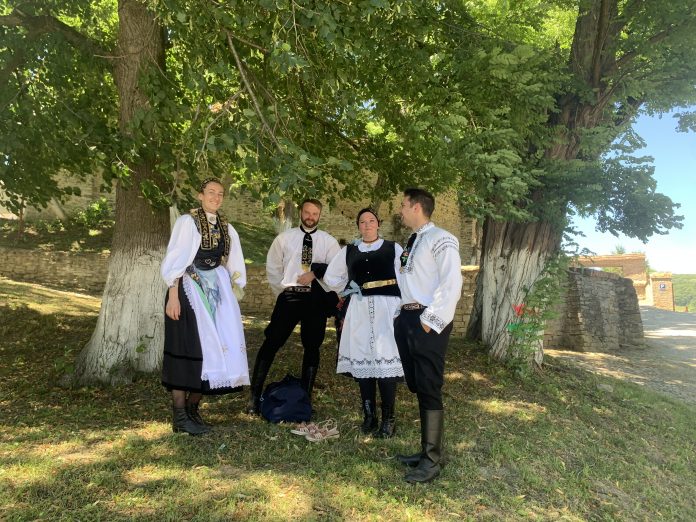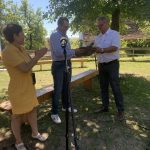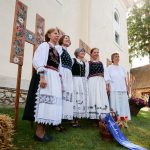There is something ancient, something modern and something utterly Saxon about the Haferland Festival that takes place each summer in the rolling hills in the heart of Romania which hundreds of thousands of ethnic Germans once called home.
Ancient are the fortified churches, some of them UNESCO sites, which dot the landscape and were paid for by the industrious and self-reliant Saxon community after it moved to the area in the 12th century.
Modern Networking
The festival in itself is an event of our times, featuring drones that chronicle the event, top-notch hospitality and modern networking.
But what gives it its Saxon, or ethnic German flavor, is the superb organization and reaching-out-of-the community qualities that have made the community one of the most popular and solid groups in Romania for centuries.
Fittingly, the festival which means Oat land in English came about thanks to composer and musician Peter Maffay and entrepreneur and philanthropist Michael Schmidt who was born in the Saxon village of Crit, a hamlet of 600, before emigrating to Germany and then returning to build business.
Michael Schmidt and his wife Veronica are the motor of the event and invite well-known personalities, politicians from Romania and Germany, diplomats, Saxons who live in Germany as well as thousands of tourists.
Saxon community
Last year, the festival was a high-octane political event after President Klaus Iohannis, then-Premier Nicolae Ciuca, then-Foreign Minister Bogdan Aurescu and several other ministers attended the highlight event on Sunday morning in the Crit church courtyard. They praised the Saxon community as an example of a constructive and harmonious ethnic minority.
“Last year was very successful. We had 15 million views (of the event)—people who found out about it. I’m proud of this achievement and I believe this obliges me to continue. It’s proof of the festival’s success thanks to visitors and dance groups and bands who come from Germany to perform. They give color to this event,” Mr Schmidt said.
This year’s festival_ the 11th edition_ is focusing on sustainability and is taking place under the patronage of His Serene Highnesses the Prince and Princess Alexander von und zu Liechtenstein. It’s the first time when they have patronized a cultural event in Romania.
Oats
The Saxons arrived in Romania the 12th century and over the years built 250 fortified churches in southern Transylvania where they settled, also known as the Transylvanian colinde or highlands. The harsh climate meant they grew oats in the areas they settled
Standing in the gentle shade of the church courtyard on a scorching hot Saturday morning, Dr Werner Kloos, the head of the Regional Association of Transylvanian Saxons said that the 200,000 Saxons who moved to Germany before communism ended and immediately afterward wanted to “build bridges” with the small community and Romania “and not walls.”
Marlies Makel Gherghiceanu, the curator of the Viscri fortified church said: “My parents left for Germany as they’d had enough of Romania. I left Germany and returned to Romania as I’d had enough of Germany,” she told a crowd gathered in the courtyard of the Viscri Saxon church.
Hard currency
The small and well-organized Saxon or German minority punches above its weight. Thousands emigrated during the communist regime— sold by Communist leader Nicolae Ceausescu for hard currency, and thousands more departed immediately after his downfall.
Viscri or Weisskirche in German is also home to Britain’s King Charles III who owns a property there which is open to the public, featuring his watercolors, an exhibition of the ties between Romanian and British royalty and a selection of books and tasteful souvenirs, including coronation champagne.
It was one of 6,000 Romanian villages that were earmarked for destruction and oblivion before Ceausescu was overthrown and executed in 1989.
Haferland
Haferland started on Thursday and will run to Sunday in ten villages located in the historical perimeter called Haferland or Oat Land, between Brasov and Sighisoara: Archita, Saschiz, Homorod, Rupea, Criț, Roades, Meșendorf, Cloașterf, Bunești and Viscri.
On Friday, Evangelical Church of Rupea, one of the oldest religious monuments of the Saxon community in Romania was reconsecrated.
There are also concerts of organ and Saxon music, including a concert at Crit church on Saturday evening featuring Cecilia and Matilda Noble, the daughters of British Ambassador Andrew Noble, a regular visitor to the festival who has a keen interest in Transylvania and the small Saxon community.
Liechenstein prince
Prince Alexander von und zu Liechtenstein family are supporters of sustainability.
Together with their daughter, Princess Theodora, Prince Alexander and his wife Priincess Astrid have long been involved in cultural regeneration and environmental conservation projects, including in Romania, which they have already visited.
Princess Theodora, together with the Green Teen Team Foundation, which she founded, supported the bison reintroduction project at Magura Bison in Armeniș (protected area of approximately 59,000 hectares, located in Caraș-Severin County).
The program of the 2023 edition of the Haferland Week festival can be found on www.haferland.ro, as well as on the https://www.facebook.com/haferland and https://www.instagram.com/saptamana_haferland/ pages.
The current edition is funded by Brasov County Council, co-financed by the Ministry of Culture and organized in partnership with „Dimitrie Gusti” National Village Museum in Bucharest, Remarul 16 February, CON-A, Bosch Foundation Romania, Aqua Carpatica, Samburesti Domains, CEC Bank, Rompetrol, Ravago, Sefar, Caparol, Autonet, MHS Truck & Bus and Automobile Bavaria, media partners KISS Fm and Calea Europeana.






















Charlie boy is not „Britain’s King”! He is the King of England. He certainly isn’t the king of Scotland!
I don’t get why Romania is so excited about this controversial, at best, figure.